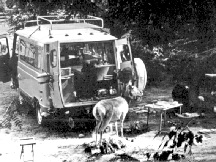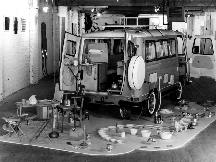- MAIN INDEX | ARTIST INDEX
| July 11 - 31, 1986 Fred Douglas
| |
 Fred Douglas, The Van, installation view, 1986. Photo courtesy Fred Douglas. 18K |  Fred Douglas, installation view, 1986. Photo courtesy Fred Douglas. 18K |
| PRESS RELEASE Continuing in our series of satellite projects, Mercer Union is sponsoring an installation by Vancouver artist Fred Douglas. Located at the Harbourfront Sculpture Court, The Yan will open on Friday July 11 at 5:30 p.m. The artist will be present for the opening. The installation will be-on view through July 31 and will be attended by the artist on a regular basis. The Van is a 1963 Morris van refurbished into a fully functioning recreation camper. An icon of mechanized, portable architecture, The Van is outfitted with an eclectic array of accessories ranging from commercially produced furnishings to man-made imitations of the natural world. Once situated, Fred Dougas empties the van of all its contents and then in a categorical order, displays them around the outside circumference of the van. The Van illustrates man's flirt with the wilderness. Ultimately, Douglas' camperized vehicle serves as a metaphor of man's psychological need to surround himself with objects which symbolize his undaunted romance with his natural environment.
Initially, Douglas created The Van as a tableau to be photographed as one in a series of photographs documenting everyday life: "In the resulting photographs the difference between the real or natural and the contrived became problematic. Some of these set-ups resolved themselves more vividly as performance pieces or installations than they did as photographs. The Van is one such piece. It was an attempt to make a thing which would not give up its status as a real thing in the mundane world and yet would somehow reflect on this status, as well as being the basis for a photographic picture."
FRED DOUGLAS, Harbourfront Sculpture Court Curious campsite creation
Connie Hitzeroth Fred Douglas' The Van is a classic what's-wrong-with-this picture scenario. A fully outfitted 1963 Morris camping van is parked quietly but determinedly outside the Harbourfront Queen's Quay on the lawn. Breakfast is underway, coffee pot brewing on the camp stove, water hooked up for dishes, van doors are open ready for a sweep-out. The whole scene, however, feels oddly unlived in: no smells, no sounds; indeed, many of the van's contents within and surrounding are curiously arranged as though on display in a store window. This unsettling scene arrives in Harbourfront's sculpture court this weekend. "No aspect of the van is unimportant to its understanding--even the labels on the cans of food are part of. what- you need to understand the work. Each part echoes the form as a whole, nothing is generalized,' says Douglas "I've photographed The Van hundreds of times. That's why I made it: to photograph it. I am a photographer. I make huge enlalgement photographs so that all this detail can be seen. Then I selectively tone (selenium and sepia) parts of the print as well as paint it with airbrush. While the finished print is clearly a photograph it is also painterly. "My intent, therefore, was never to use the van as an installation as it is being exhibited here, but only as a prop for my photographs. I am pleased, and only too happy to engage in this form of art if that's how people respond to my work, but I don't think I'd self-consciously plan to make an installation work. I still want to continue investigating how the fiction in a photograph can be broken down." Van photo "My idea was to make The Van as a photograph because I am interested in analyzing the veracity of a photograph. In the history of Renaissance man photography is one of the newer kinds of fictions we've involved ourselves in. Whereas painting and drawing and printmaking use a 2-D space to create the illusion of a 3-D space to create a different illusion. To do this I set up situations where there are obvious conflicts in the fiction at hand." In 1972 Douglas began work on a project for the Vancouver Public Library to photograph Unglamorous Images of Everyday Iife in BC. Taking that theme, and situating his slices of life in what he calls idyllic, Arcadia-like impossibilities, Douglas has the viewer uneasily poised between what one expects to see and what one learns will never be. In addition to The Van, Douglas has made a Dinner Party and is working on a Dead Soldier. and a Beaten Boxer. "I will photograph The Van on site at Harbourfront and will be making a finished photo artwork from it. People have asked me to make The Van a performance with people in it, but it would totally spoil the piece, ruin the balance between what people could expect to see in real life and what an archaeologist would display as an in terpretation based on findings of what once was." But to spite Douglas' intentions, The Van, with an almost human determination, has taken him into performance art work. For this exhibit at Harbourfront is the first time that The Van has stayed outdoors longer than to be photographed, and Douglas will be obliged to not only spend hours every day loading and unloading the contents, but to also keep a watchfull eye on his movie set that is bound to be perceived by visitors at Harbourfront with a broad range of assumptions.
| |